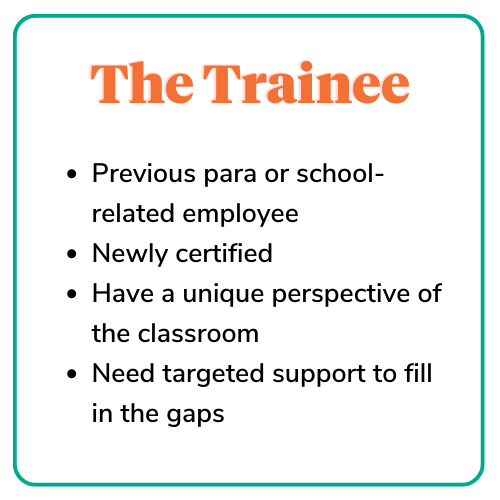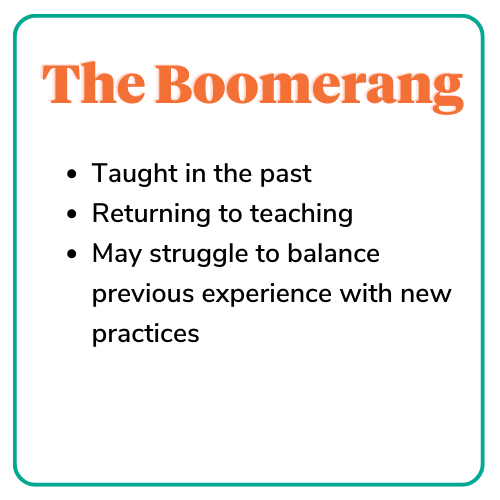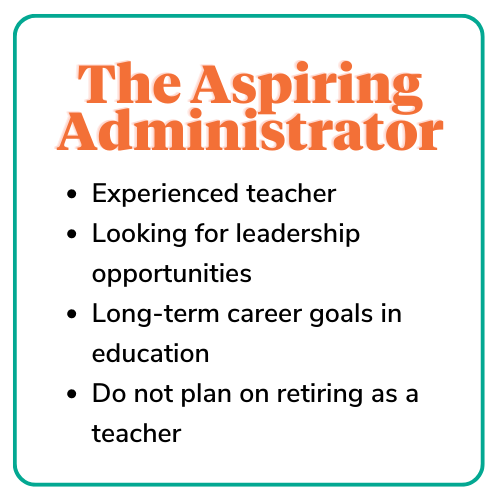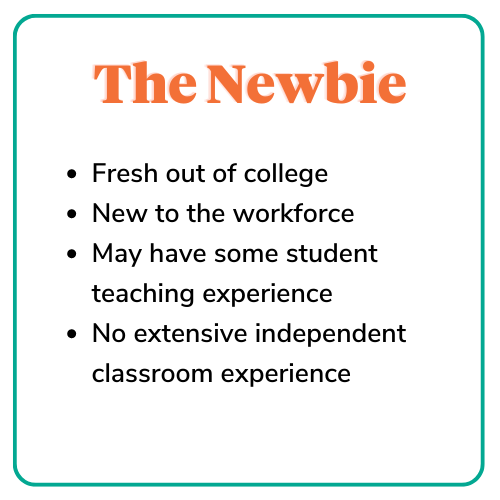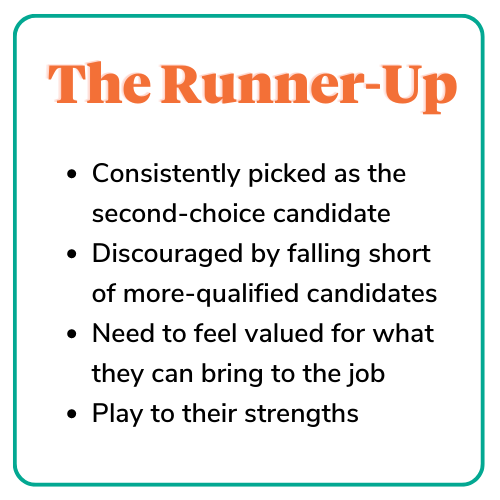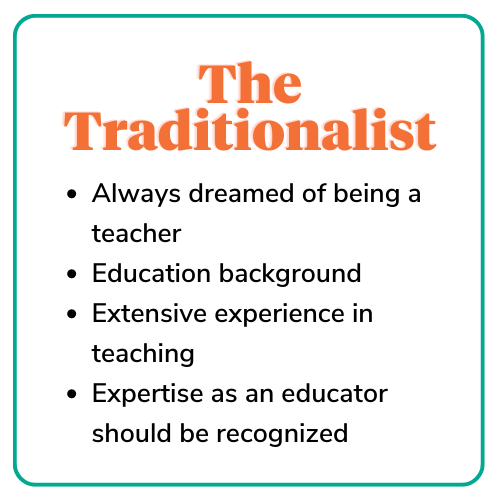Recruit More Teachers: 15 Tools and Strategies
Recruiting teachers isn’t getting any easier. Districts across the country are scrambling to recruit more teachers and fill large amounts of classroom vacancies.
We’ve put together a bank of tools you can use to start hiring teachers now, including an opportunity to post your jobs for FREE with 240 Jobs.
Overview
Although the situations, budgets, and resources differ across school districts, the recruitment tools that teacher recruiters use to hire teachers can be the most valuable element in staffing classrooms.
If you’re overwhelmed with what to do or where to start, you’ve come to the right place. Take what you need and share what works. (Especially Tool #15…we saved the best for last!)

“I have been in your shoes. As a Director of Recruitment and Engagement for a large Florida school district, I quickly realized the importance of a reliable resource. Just like when I was in the classroom, I found that district recruiters are recreating the wheel instead of sharing what works.
Below you will find a gold mine of turnkey-ready resources with a note of how I personally used these ideas to improve recruitment in our school district. I’ve also chunked them into four main aspects of recruiting: planning, advertising, sourcing, and engagement.”

Planning
Tool #1: Recruitment Calendar
Definition: A prioritization tool to identify the recruitment focus and tasks for each month
Main Benefit: Keeping the entire team aligned each month on recruitment goals and strategies
A recruitment calendar provides a recruiter with a high-level perspective on the different goals throughout the year. The value is that it connects with the team’s overarching mission: recruit and hire enough qualified teachers to meet the demand for the upcoming school year.
A recruiter’s focus in November is far different from the focus in May. The attention can change from preparation to sourcing candidates to screening and placement into the right schools.
If we don’t purposefully chart out each Recruitment Season’s focus, we impulsively move from one job fair and online job post to the next. That leaves little time to plan for what’s coming up or evaluate successes and failures.
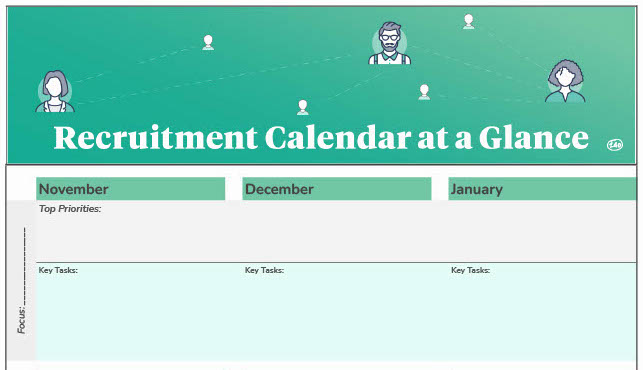
Why use a recruitment calendar?
Creating and referring back to a recruitment calendar can give you and your recruiting team the structure and focus they need to reach their goals. We’ve even created a template for you to write in your own priorities and associated tasks that align with the ebbs and flows of your work.
Consider what’s important at each part of the year, who your intended target audience is, and what tasks need to be in place to get the best teachers in your classrooms the following school year.
Tool #2: How-to-Guide: Build Your Teacher Recruitment Strategy
Definition: A formal plan outlining the plan of action a recruitment team will take to source, recruit, and hire top talent
Main Benefit: Optimize the resources used to recruit teachers and align recruitment efforts with an overarching goal
A recruitment calendar is just the launching pad to creating an overall recruitment strategy – a plan that every recruitment team needs to lay out the course of action formally they’ll take to source, recruit, and hire top educational talent.
In a world where finding teachers is becoming increasingly challenging, now more than ever, teacher recruiters need to take time out to build a solid strategy for recruitment. Schedule some time on your calendar and use our Recruitment Strategy How-to-Guide to reflect on your practices, align your resources, create a timeline, and plan to sell why your school or district is the best place to teach.

Tool #3: Hiring Needs Calculator
Definition: A document that calculates the number of candidates a district needs to hire based on current and historical data
Main Benefit: Hire with a concrete number in mind rather than a guess or estimate
There are many benefits to utilizing data when recruiting candidates. Some to note are:
Most importantly, it can assist recruiters with determining organizational needs rather than recruiting and hiring into oblivion. As you start considering what type of data you should be using to calculate needs, we recommend considering the data listed below or any other data relevant to the hiring goals of your district.
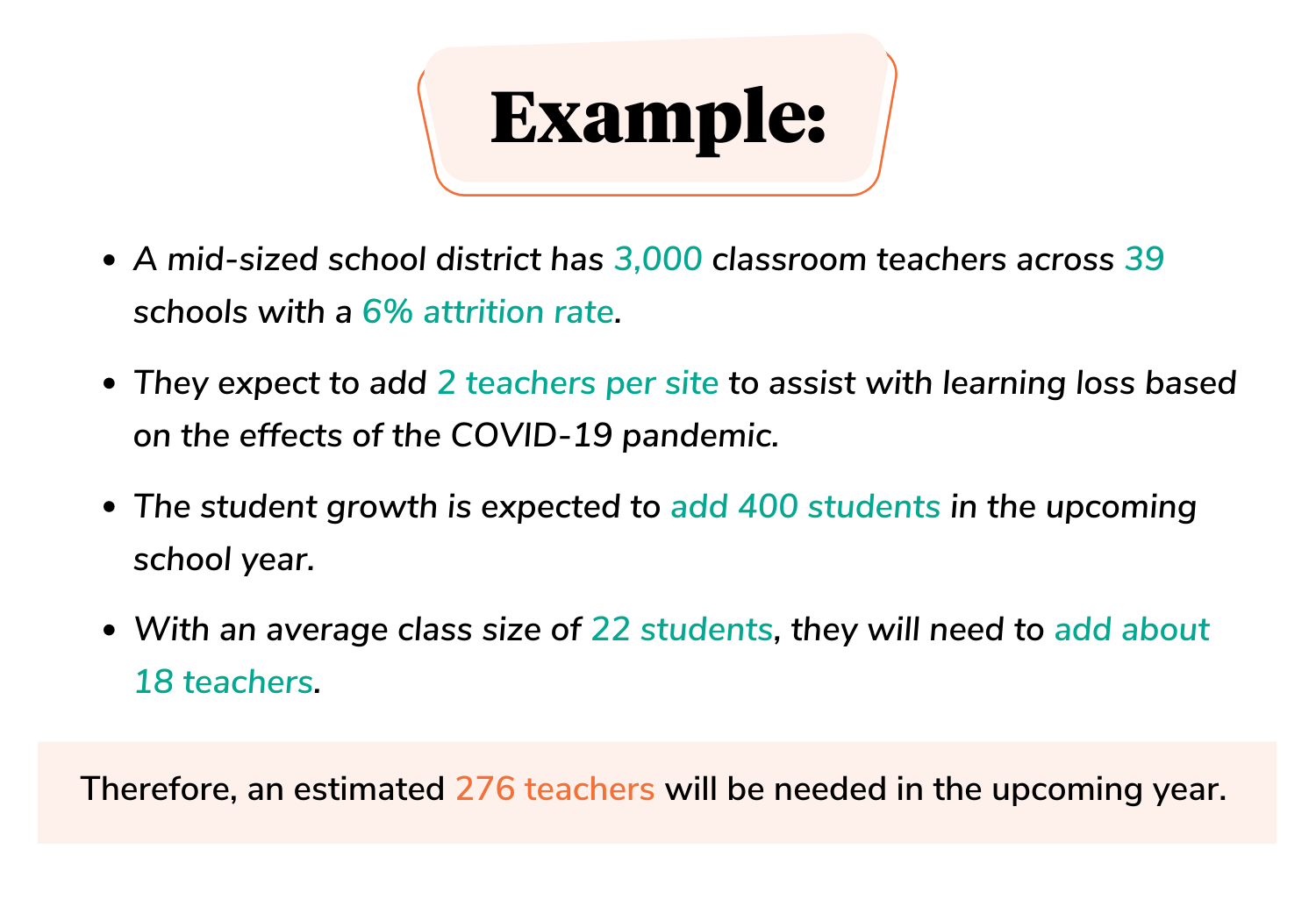
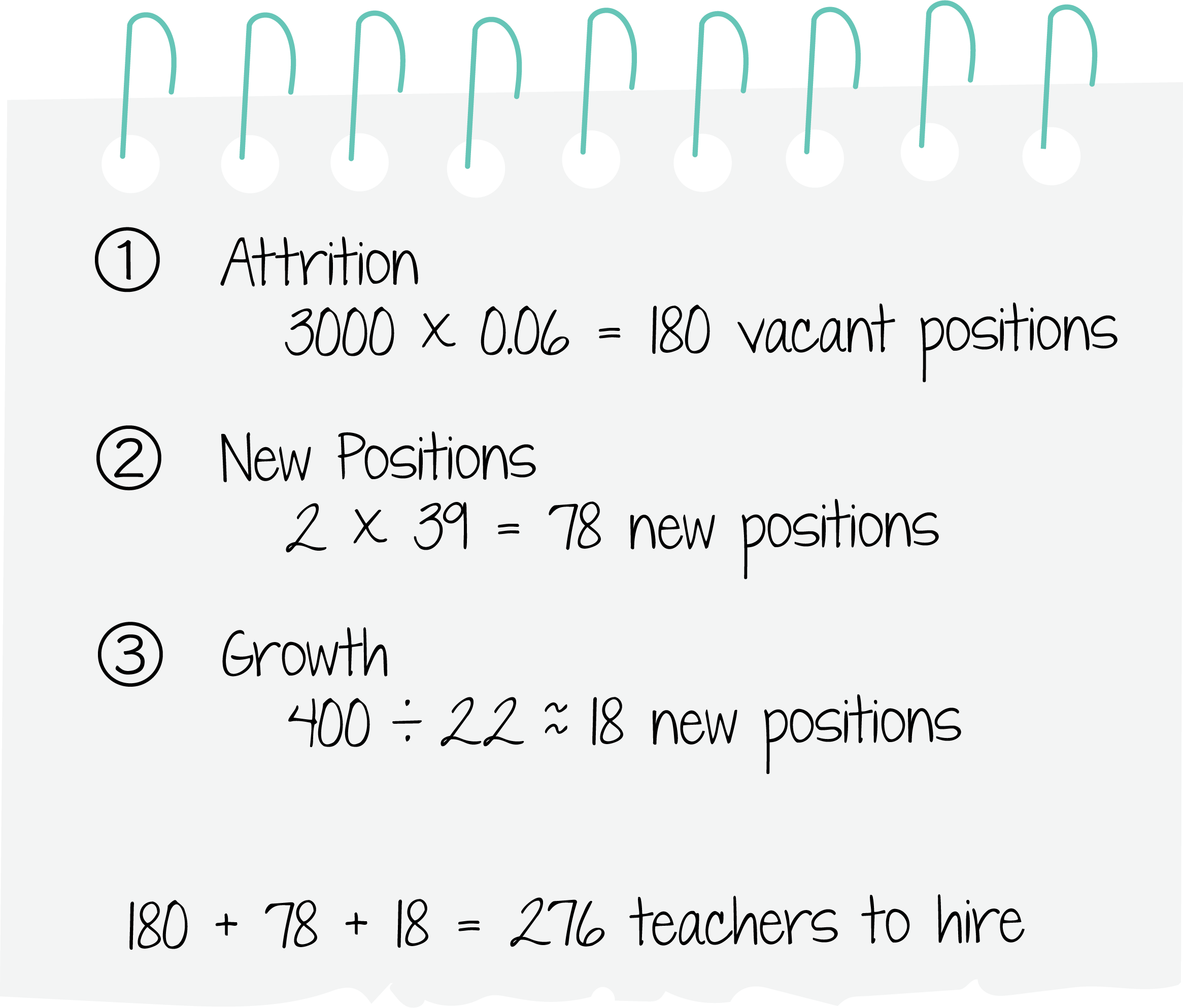
Before you begin sourcing candidates, we recommend calculating how many candidates you need to fill your anticipated vacancies. Use our Hiring Needs Calculator to create a clearer recruitment goal using your own data. You might be surprised at what you’ll find!
Tool #4: Job Fair Calendar
Definition: A tool to organize the tasks and outcomes for job fairs the team attends
Main Benefit: Information and task progression is tracked in one place. Recruitment teams can refer back to the document to determine which fairs are worth attending the following year
Most districts use job fairs to staff their positions for the upcoming school year. The debate continues with each year post 2020 about which is more beneficial: virtual or in-person job fairs.
We wonder the same thing.
So we asked about 800 teacher candidates using our study guides if they plan on attending job fairs and, if so, which type. Surprisingly, nearly 37% said they don’t plan on attending job fairs at all. This suggests that districts are being proactive in reaching these candidates and securing hires before they have a chance to attend a fair.
For the other 63%, job fairs are still an option, but not many choose to stick exclusively to virtual events.
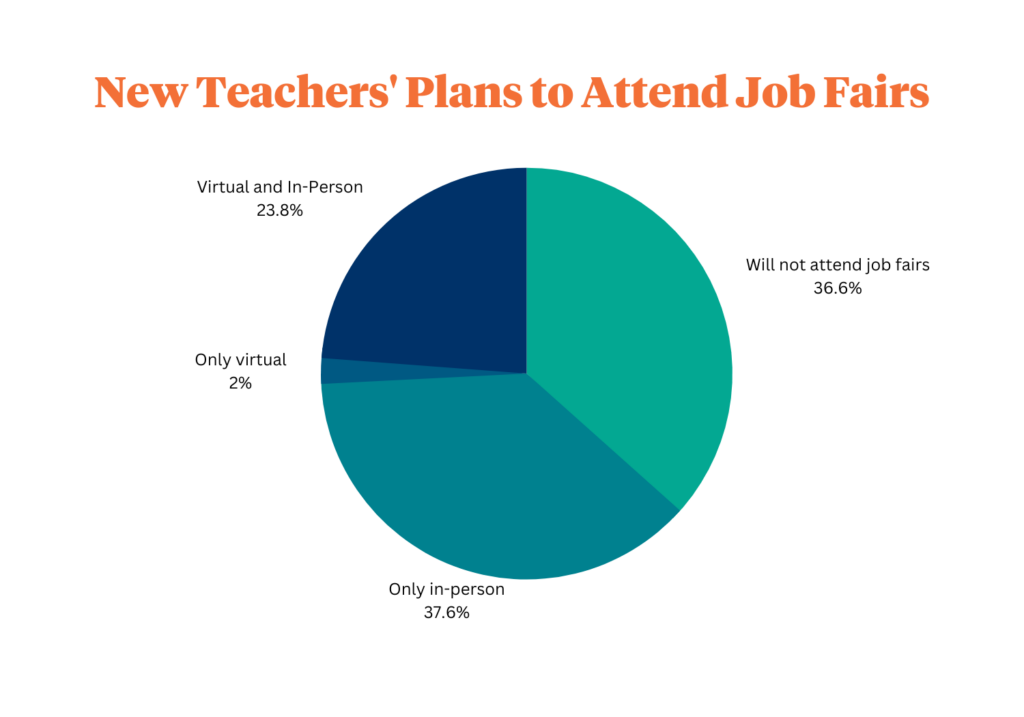
Clearly participating in job fairs will continue to be a top recruitment strategy. But in order to make the most of the time, money, and energy recruiters will spend at job fairs relies on planning and organization.
The difference for planning for an in-person, out-of-state fair can vary greatly from attending a virtual job fair from the comfort of your office. With all the events recruiters attend each year, it can get overwhelming to keep track of what’s been done and to evaluate if attendance in the future is worthwhile.
Using a job fair calendar helps track candidate engagement, resulting hires, and expenditures associated with each fair. Then, the following year, the district can reference the document to determine which fairs to attend based on the data collected.
It’s a great resource if you need help keeping track of:
I can see a Type A, organized recruiter jumping for joy in the distance.
You’re welcome!
Advertising

Tool #5: Social Media Calendar
Definition: A tool to plan and organize all social media posts shared by the recruitment team
Main Benefit: Alignment of messaging across platforms and consistent coverage throughout the year
Social media is no longer just “social.”
Your presence on social media is critical to helping to advertise or “sell” your district to potential employees. It’s your chance to showcase your schools, students, and your district’s overall culture and values.
However, simply being on social media is not enough.
To build your social media following and reach the right audience – including potential employees – you need to be intentional and organized about when you post, what you post, and how you engage with your audience.
Social Media Calendar
A social media calendar can help keep your team on track by maintaining a consistent social media presence throughout the year. It allows you to map out a general monthly overview before the school year begins.
Creating this roadmap in advance will make your job easier throughout the school year and help you stay consistent in your posts, even during peak recruiting season.
5-3-2 Model for Social Media Posts
To fill in your social media calendar, you’ll need to carefully consider what content to post. Not every post should be about job openings and job fairs. When it comes to social media content, one effective strategy is the 5-3-2 model.
This model breaks down the type of content for every 10 posts you share:
But what does this look like for school districts? Here are some of our suggestions:



Pro Tip: There can be some overlap in the 5-3-2 model. Photos from classroom activities can serve as fun or personal content as well as a way to sell your district to future employees.
Tool #6: Sample Wording for Job Posts -and-
Tool #7: Do’s and Don’ts for Job Advertisements
Definition: Frameworks for wording job advertisements on external websites
Main Benefit: Draw in more applicants by allowing the candidate to see themselves in your job advertisements through relatable and personalized wording
When it comes to the recruitment process, posting job advertisements may seem like a straightforward strategy. It may be tempting to post a job opening quickly by copying and pasting job descriptions and duties to a job site.
Bad news. This isn’t the most effective way to attract prospective teachers.
Private sector companies are now investing more time into the text of their job descriptions, and it’s paying off. We need to follow their lead.
Applicants should see themselves as a part of your team and envision themselves in the role you describe. With a few simple changes, you can completely change the energy and message of your job advertisements and start drawing in more candidates.
When reading a powerful job description, teachers should sense:
Consider the following two advertisements and the message or feeling each conveys:
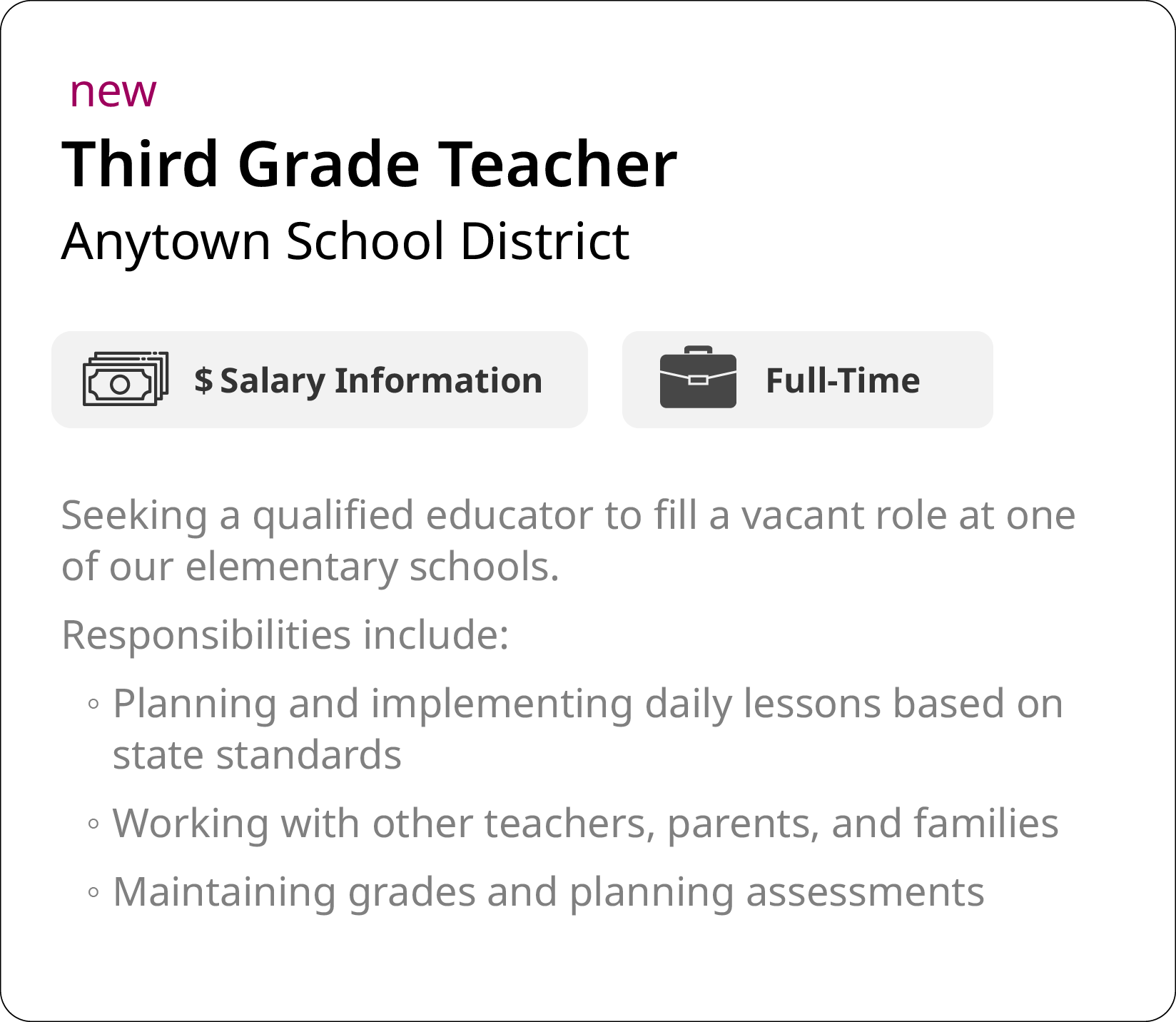
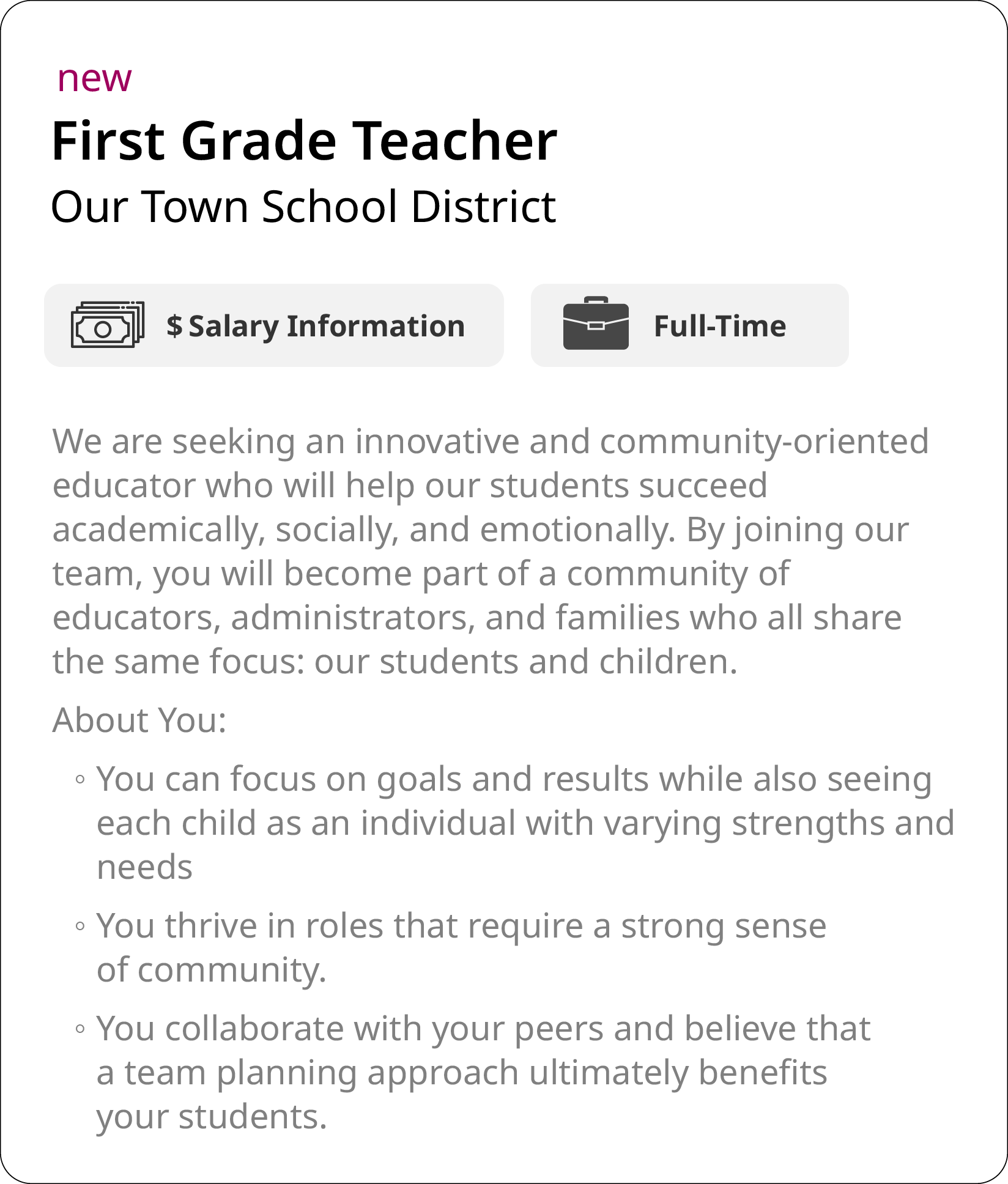
Compared with the second job advertisement, the first one comes across as unremarkable or dull. The second job advertisement evokes a sense of personalization through carefully planned word choice.
Words such as we, our team, our students, and our community makes the district feel more approachable and relatable. The “About You” section focuses directly on the prospective candidate and helps them envision themselves in the role. Prospective candidates are more likely to notice, remember, and apply to personalized job advertisements such as these.
To help your team get a jump start on personalized job advertisements, we’ve created a template with examples of wording you can use in your next job post or social media campaign.
We also recommend evaluating your advertisements with our Do’s and Don’ts Checklist. This tool can help you determine if the posts you promote are set up for success or if they are unintentionally being lost among a sea of attempts to capture teacher talent.
Tool #8: Recruitment Materials Checklist
Definition: A guide to creating top recruiting materials that “sell” your district
Main Benefit: Create recruitment marketing materials that are visually appealing and have a strong, clear message
Let’s be honest. “Selling” teaching as a profession isn’t always easy. Still, school districts must make it a priority to make their district an attractive place to work.
In a sense, districts are selling their district to potential employees. One way to do that is through enticing and relevant recruitment materials.
Recruitment materials include anything that has the potential to attract future employees. This can include district websites, social media posts, printed material, job postings, etc. When creating any recruitment material, your top priority should be making your district stand out.

Without clear and unique answers to these questions, your hiring opportunities will likely fade into the noise of all the other job opportunities a teacher candidate encounters.
After determining what sets your district apart from others, it’s time to create and design your recruitment materials. When designing any type of recruitment material, always keep the following elements in mind:
You can keep our Recruitment Material Checklist handy to help your team create material that will sell your district and appeal to future employees. We’ve done the design research for you and put it together in this “inside scoop” resource. We even had a graphic designer give some pro tips on taking your visuals from “meh” to “amazing!”
Sourcing

Tool #9: Employee Referral Kit
Definition: A comprehensive set of resources to establish an employee referral program in a school district
Main Benefit: Attract more candidates and pay your current staff to draw them in
An employee referral program provides school districts with a pipeline of highly qualified candidates efficiently and cost-effectively.
At its core, the program empowers employees to have their peers join them in their work. Successful employees act as positive representatives of the district when they are in the community. This creates an indirect recruitment opportunity to draw in more candidates.
In turn, the program pays out a bonus to the employee who recommended the new hire instead of spending larger amounts on signing bonuses.
Signing Bonus vs. Employee Referral Program
Should districts use their funds to offer signing bonuses or pay their employees for referrals?
While financial incentives seem like a great way to attract teachers into the profession, studies show sign-on bonuses have mixed reviews in terms of attracting top talent, and the likelihood of retaining these candidates long-term is slim. Many districts are turning to employee referral programs to provide financial incentives for recruitment but incentivize the current employees instead.
As a bonus, districts find higher retention rates using an employee referral program. These candidates are more likely to weave into the district’s culture easily, preventing the need to constantly replace them with new talent from year to year.
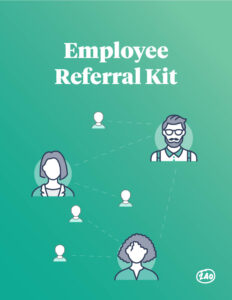
Using the Toolkit
When districts establish a program that incentivizes their staff to recruit candidates, it can greatly reduce the time a recruiter would otherwise spend sourcing those candidates. This is why we created a ready-to-use kit for districts to establish their own employee referral program.
The kit contains:
The main goal of this kit is to locate the hidden talent you otherwise would not have known existed. You can also take inspiration from other districts’ approaches here and here.
Consider how you can create your own program that aligns with your district’s budget and needs while focusing on recruiting and retaining top teachers for your students.
Tool #10: Candidate Tracker
Definition: A document that captures key information about all candidates that engage with a recruitment team
Main Benefit: Keeps candidates from getting lost or overlooked. Allows for targeted engagement, filtering, and the ability to determine ROI.
Taking the time to both track and cultivate candidates is a critical teacher recruitment strategy when filling vacancies.
But many teacher recruiters report that their bandwidth is stretched thin. They find it challenging to keep up with which candidates are sourced from each recruiting avenue.
Having a one-stop shop for organizing candidate information can keep you from allowing a critical candidate to fall through the cracks while also giving you the perfect insight to keep developing the relationship with candidates that results in a hire.
Tracking Candidates
Many school districts use an Applicant Tracking System (ATS) to source and organize applicants. Others are finding ways to use spreadsheets or available digital resources to keep up with leads.
Regardless of the platform, there are three critical factors to remember when selecting a quality applicant tracking system:
Whatever tracking system you use, it must couple with having dedicated recruiters that call, email, and even text potential candidates. Personalizing communication gives school districts an edge over the competition, making it more accessible to find a teaching position that meets the candidate’s needs.
However, personalizing takes time, something many recruiters find coming in limited supply. Recruiters screen applicants and speak to multiple candidates per day. So how can they track and personalize engagement at scale?
Our Candidate Tracker does just that.
![]()
Recruiters can categorize candidates so they know which need more engagement than others. Critical characteristics like certification coverage, area and job preference, and where they are at in the candidate journey are all recorded on this document.
Anyone on the recruitment team can open the tracker and pick up where the last team member left off. To the candidate, it creates a seamless candidate experience with them at the center.
Other benefits include:
To say this is a game changer is an understatement. It’s time to get tracking!
Tool #11: 10-Minute Virtual Interview Script
Definition: A time-based script for a recruiter to use during a bite-sized virtual interview
Main Benefit: Provides structure to an otherwise-rushed conversation and provides clarity for follow-up conversations
As the world of work moves increasingly online, job seekers, particularly new college graduates, are more comfortable completing the entire recruitment process virtually.
Virtual recruiting opens the door for districts to showcase what makes them unique. It has also allowed them to create a more equitable hiring experience and improve hiring staff and teachers of color. Removing barriers to the application process by allowing for flexibility through virtual connections can help increase the size and engagement of a candidate pool, and what recruiter doesn’t want that?
Anatomy of a Virtual Interview
Suppose your district has decided to conduct some or all of your recruitment efforts virtually. In that case, you will no doubt be faced with a bite-sized virtual interview to determine candidate quality as a part of participating in a virtual job fair.
Some virtual job fairs can limit discussions to as little as 10 minutes, making it essential for recruiters to quickly get what they need while creating a positive candidate experience.
We recommend sticking to this “anatomy of an interview” to ensure you’re creating a quality virtual experience and getting a better understanding of the candidate.
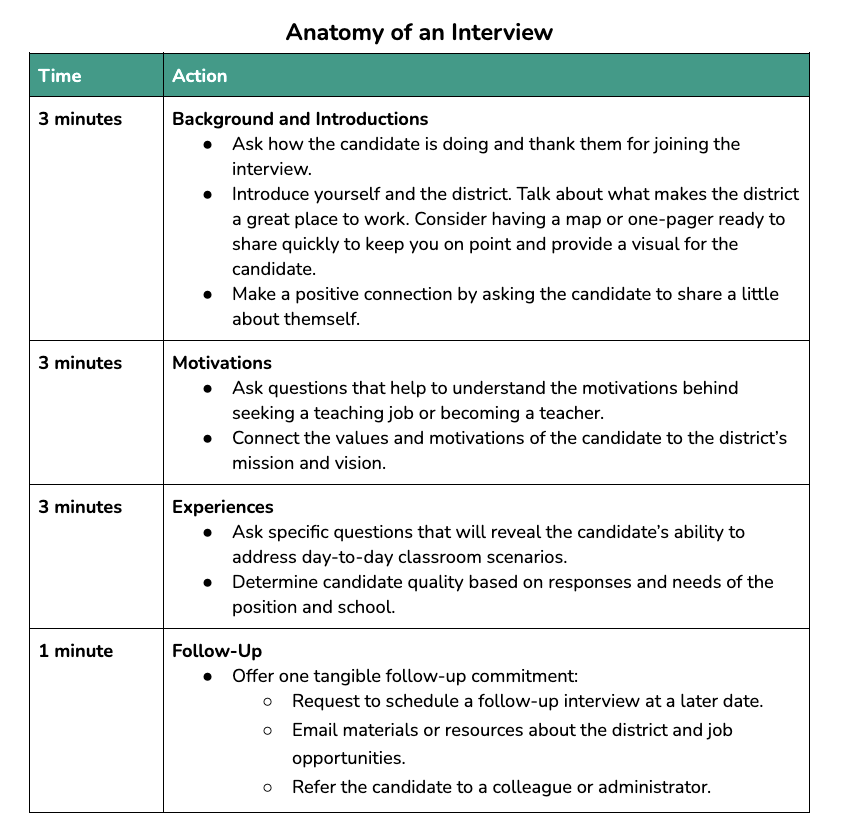
To help keep the conversation moving and productive, we’ve created a 10-Minute Virtual Interview Script for recruiters to use in a virtual interview.
Tool #12: Interview Screening Tool
Definition: A document that captures interview notes, scores, and next steps for multiple candidates
Main Benefit: Streamlines the evaluation and referral process of multiple candidates
The goal of a brief virtual interview is to lead to a longer virtual or in-person interview. In a snapshot, the teacher recruiter must build rapport, sell the district, and present a call to action for the next steps.
Having a tool available to capture the conversations is critical to keeping up with the details and creating a positive candidate experience.
Whether you are conducting interviews virtually or in person, we recommend synchronizing your notes and candidate engagement in one spot. This Interview Tracking Worksheet is a great tool to help you track your conversations and collect information in one place, making it easier to conduct follow-ups later. It also provides a rubric to standardize candidate evaluation and streamline the referral process.
Engagement

Tool #13: Candidate Persona Engagement Tool
Definition: A guide to engaging with the different types of candidates that apply for teaching positions
Main Benefit: Deliver communication that aligns with the unique values, priorities, and backgrounds of each applicant
Candidate personas provide hiring teams with general profiles of the different types of candidates they will encounter. These personas help bring candidates to life by tapping into each applicant’s specific values and backgrounds and their main priorities related to their career.
Candidate personas can help guide recruitment conversations from initial outreach to final interviews. For example, a conversation with a young candidate just out of college will differ tremendously from one with an experienced teacher.
Consider all the Personas
While some districts focus on creating one ideal candidate persona – a picture of the perfect candidate they would like to hire, we recommend a different approach.
We believe that it is more effective to have a collection of the multiple types of candidate personas you are likely to encounter in the recruitment process. Successful and effective educators come with various experiences, motivations, and backgrounds. Having just one ideal persona can cause districts to overlook or have an unintentional bias against other strong candidates.
Based on our data from customer interviews and our experience in education, we’ve found that applicants typically fall into one of the following personas:
With these personas in mind, we’ve created a Candidate Persona Engagement Tool to help your team create a more customized experience for each applicant. This resource suggests ways to communicate with each candidate persona, including outreach methods, email templates, conversation starters, and interview questions. These personalized and effective conversations will ultimately help set your district apart from others, making you more appealing to the strongest candidates.
Tool #14: Candidate Communication Guide
Definition: A blueprint for communicating effectively with candidates at each step of the candidate journey
Main Benefit: Candidates receive relevant and engaging information at each stage of the candidate journey
When communicating with candidates, hiring teams may use a “one-size-fits-all” approach or worse – little to no communication at all. These mistakes cause applicants to feel left in the dark and ultimately abandon the application process.
Avoid this pitfall by communicating with candidates throughout each step of the application process and by adapting your communication strategies along the way.
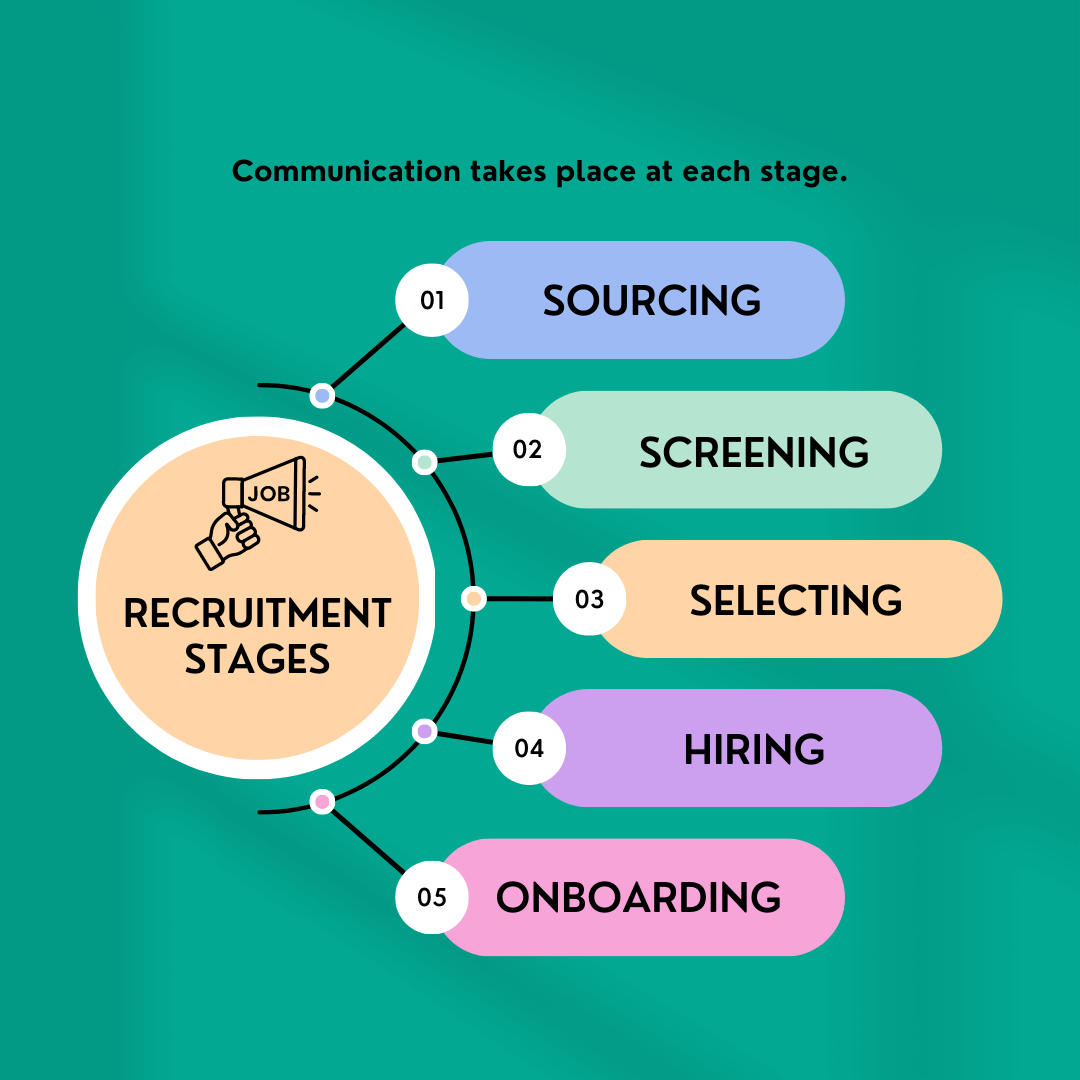
Communication at Each Stage
Put yourself into the applicant’s shoes and consider the information they are receiving (or not receiving) along the hiring journey. You may know that you will schedule an initial interview within two weeks, but does the candidate know this?
Research shows that most job applicants are kept out of the loop regarding interview timelines and how far along they are in the process. Applicants who feel informed and updated are less likely to abandon your application and interview process.
Different forms of communication are better suited to different steps of the recruiting process. In the early stages of initial outreach, the most effective communication method may be email or an online chat feature on your website. After in-person interviews, direct phone or video calls may be more appropriate and better appreciated by candidates.
Our 240 Tutoring study guide users say they prefer email communication for job information but are also open to other communication modes based on how serious they are about a position.
Regardless of the recruitment stage, communication is the only way to ensure a candidate makes it to their first day in one of your classrooms. Our Candidate Communication Guide is the perfect tool to guide your conversations each step of the way.
But what about when they don’t get the job?
A crucial but often overlooked conversation is the one that takes place when an applicant is not selected. Hiring teams often rely on standardized “rejection letters” for passed-over candidates.
We suggest reconsidering this process, particularly for candidates who were a “runner-up” or nearly selected for the job. These are candidates who you may want to reach out to in the future for a different position, but a standardized rejection letter can make them reluctant to apply to your district in the future.
Survale, a talent experience platform, has an innovative take on this by addressing the potential for rejection at the beginning. They suggest even going as far as creating a candidate pledge to ensure transparency regardless of the outcome.
Tool #15: Stay Interview Kit
Definition: A comprehensive resource to facilitate discussions with top educators in order to bolster recruitment and retention efforts
Main Benefits: Get inside information about what is and isn’t working in your schools
A largely untapped resource in teacher recruitment is widely available and right in front of you: the voices and opinions of your current teachers.
Integrating teacher voices into your marketing helps prospective employees get an authentic feel for what it’s like to work in your district. It can also help convey your district’s employee value proposition or EVP. Your EVP is what sets your district apart from others. Your current employees know firsthand the unique benefits of working in your district, both explicit and implied.
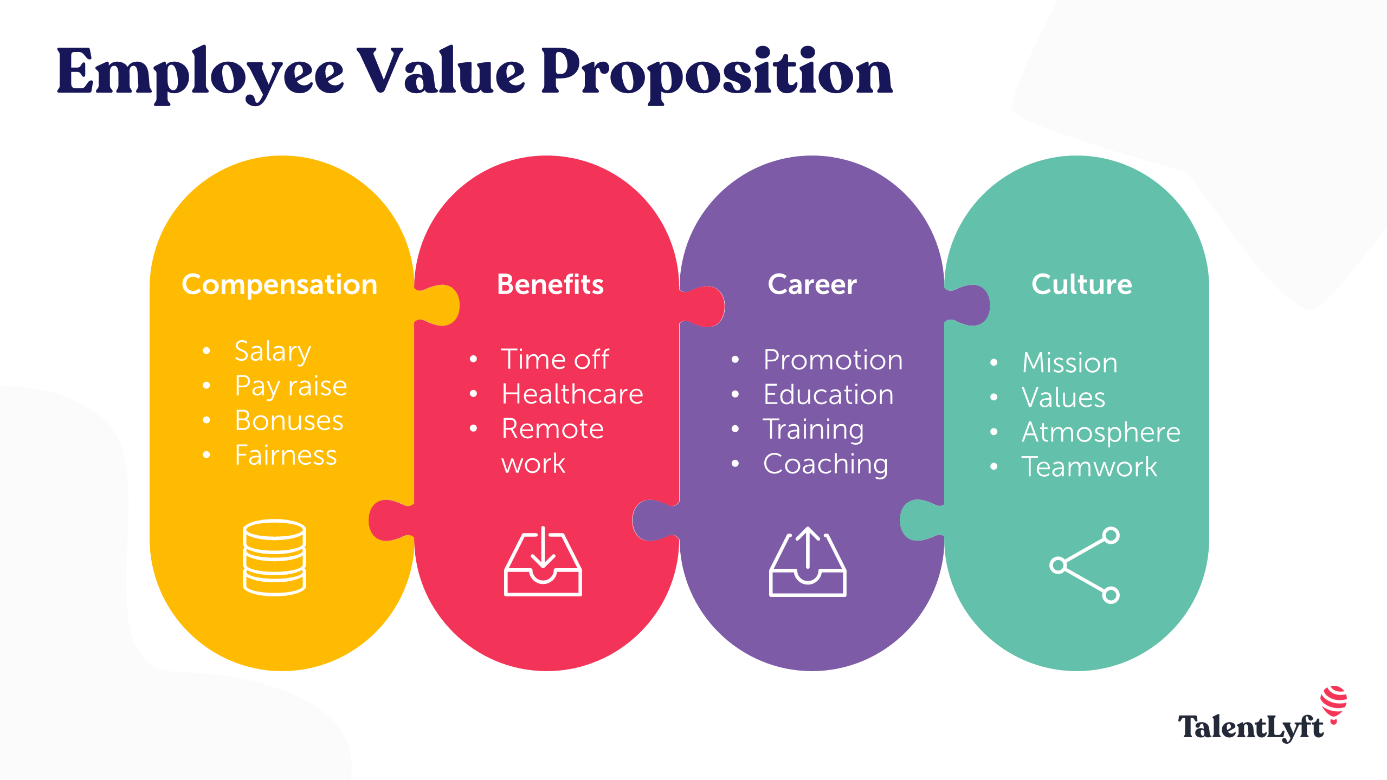
15.EVP
Source: Next Technology Professionals
But what is the best way to get the genuine opinions of your current staff?
Carefully planned questions can help identify specific examples of what teachers love about your district. Consider using some of the following questions when talking with current employees:
Share these direct quotes on your website, social media, and marketing materials. Connect them with your district’s core values and show their faces on your careers pages. The important thing is to let candidates hear straight from your staff about why they love working for you as often as possible.

15.Stay Interview Kit
Photo Credit: Polk County Public Schools
Stay Interviews
Double the bang for your buck by using this questioning as a retention strategy for your top teachers. School leaders can integrate these strategic questions into a stay interview.
Unlike an exit interview that acts more like an autopsy, a stay interview serves as a diagnostic tool to indicate the factors impacting retention while you still have time to fix it. Conducting stay interviews with your top teachers can help you identify some of the unique and specific reasons your teachers choose to stay in your district.
For stay interviews to be most effective, allow teachers to share their concerns and suggest improvements candidly. They need to see the intentionality behind the conversation. It goes without saying that it should not be evaluative in any way. Seeing their feedback resulting in action speaks volumes to the commitment of the administrator and further drives long-term retention for your irreplaceable staff.
Ready to start the conversation?
We’ve got it all laid out for you from start to finish. Check out our Stay Interview Kit and get the ball rolling on these crucial conversations.

